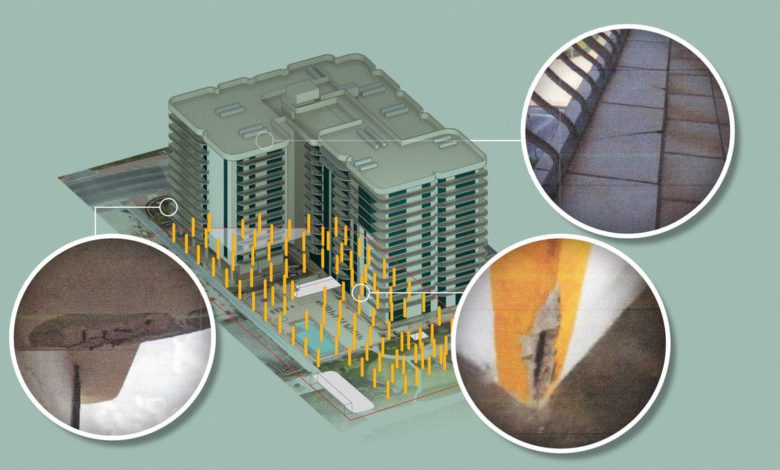
Once the crackling started and the pool deck gave way, residents of the doomed Champlain Towers South had mere minutes before their world literally crumbled.
The 12-story oceanfront condo in Miami collapsed into a heap of concrete and metal last week, killing more than a dozen people and presumably trapping nearly 150 more. One person was rescued alive.
As sudden and horrific as the tower’s final moment of failure was, clues about what might have contributed to it had been accumulating for years:
A former maintenance manager said saltwater infiltrated the foundation during high tides as early as the 1990s. A condo owner mentioned multiple maintenance failures in a lawsuit she filed against the complex in 2015.
The biggest red flag came in 2018 when an engineer noted a “major error” in the building’s design and structural issues in need of repair.
What followed was three years of mixed messages, turmoil among condo association board members and hand-wringing by building residents over the multimillion-dollar price tag to fix the problems.
USA TODAY pieced together a timeline of those events, starting with the inspection report in 2018 until the moment of the structure’s partial collapse. Although residents at 8777 Collins Ave. knew about some of the issues plaguing the condo, no one understood they were dealing with a ticking time bomb.
Not until it was too late.
Engineer in 2018: 'Major error' in design of building, concrete cracking
As Champlain Tower South approached its fourth decade, the condo association hired engineering firm Morabito Consultants to help it prepare for its mandatory 40-year recertification due in 2021.
Miami-Dade County mandates the recertification for commercial and multifamily buildings when they turn 40, and Champlain wanted to get a head start. Morabito Consultants began inspecting the building in 2018.
After the inspection, residents of the 136 units got news no condo owner wants to hear: The building was in desperate need of repair.
Engineer Frank Morabito was direct in his report October 2018 to the building’s condo board treasurer: There was a “major error” in the design. The waterproofing for the entrance drive, pool deck and planter didn’t drain.
The water just sat there until it evaporated.
“Failure to replace the waterproofing in the near future will cause the extent of the concrete deterioration to expand exponentially,” he wrote.
In the parking garage beneath the building, the report noted, “abundant cracking and spalling of varying degrees was observed in the concrete columns, beams, and walls.”
Spalling refers to the deterioration of concrete, sometimes causing flaking and the exposure of reinforcing steel bars known as rebar.
Morabito gave no indication the building was unsafe, but he said the repairs were necessary for “maintaining the structural integrity” of Champlain Tower South.
In a separate report to the city in anticipation for the recertification, Morabito said the concrete slabs in the garage and plaza had experienced “concrete deterioration,” and the balcony structural floor slabs showed hairline cracking.
The report noted additional spalling or cracking in concrete columns and exterior walls.
Morabito Consulting said in a statement after the collapse that it had been rehired this month to come up with a building and restoration plan.
It provided the condo association with an assessment of the “extensive and necessary repairs” needed and a cost estimate.
“Among other things, our report detailed significant cracks and breaks in the concrete, which required repairs to ensure the safety of the residents and the public,” the statement said.
Champlain Tower South resident Jay Miller said everyone in the building knew about the 2018 report warning of major structural damage, but the concern wasn’t the problems so much as the cost.
The initial multimillion-dollar price tag for the repairs led to turmoil on the condo association’s board, Miller recalled. A new board of “extremely dedicated and conscientious people” took over, Miller said.
Marta Castro, a resident of Champlain Tower East, said she routinely talked to people in the south tower who voiced concern about the assessment.
“They had been talking about it for quite a while,” she said. “The few I talked to were concerned about the financial aspects of it.”
Aventura attorney Daniel Wagner, who sued the condo board in 2015 on behalf of a resident because of damage caused by water leaks, said there is always a push-pull among the board when it comes to significant repairs.
“I've observed that boards of directors and unit owners prefer to keep maintenance low and not assess special assessments for the general and required maintenance of their buildings to attract buyers and keep market values up to the detriment and safety of the unit owners,” he said.
More: Inspection reports for collapsed Miami-area condo detail 'major structural damage' over garage
Surfside top building official claimed in 2018 building 'in very good shape' despite deterioration
If there was cause for concern by the residents or the condo board, the city of Surfside put those fears to rest.
Ross Prieto, then the town of Surfside’s top building official, received the Morabito report in November 2018 along with an estimate for repairs of $9.13 million.
Prieto told the Champlain Tower South Condominium Association that he reviewed the report and “it appears the building is in very good shape.”
The next day, Prieto emailed then-Surfside town manager Guillermo Olmedillo and said the “meeting went very well.”
“The response was very positive from everyone in the room. All main concerns over their forty-year recertification process were addressed. This particular building is not due to begin their forty-year lease until 2021 but they have decided to start the process early which I wholeheartedly endorse and wish that this trend would catch on with other properties.”
Prieto did not return calls and messages left by USA TODAY. He told the Miami Herald he didn’t remember getting the report. He took leave from his position in the town of Doral as its temporary building official.
More: Building that collapsed deemed in 'very good shape' by town official in 2018
University 2020 report: Champlain Tower South was sinking
As condo residents grappled with the cost of major repairs, a team of researchers at Florida International University published a study showing where land in the Miami area was sinking.
The study found that most land was not sinking appreciably, save for a few hot spots, mostly in the western part of Miami, where the elevation is lower.
One area in the east stuck out as an exception: the exact spot where Champlain Tower South sat.
Researcher Shimon Wdowinski, a professor at FIU’s Department of Earth and Environment, found the land under the condo was sinking at a rate of about 1.9 mm per year during a six-year time frame in the 1990s. If the rate of sinking remained consistent, the building would have sunk about 2 inches over the past 28 years.
That level of sinking observed typically results in impacts to buildings and their structures, Wdowinski said, adding that he doesn’t know what caused the collapse.
The study’s publication in April 2020 probably escaped the attention of condo owners and building officials because it was never intended as a way to predict building failures.
The bulk of it focused on potential flooding hazards, not engineering concerns. The study’s mention of the condo was relegated to a single line.
“We didn’t give it too much importance,” Wdowinski said. The catastrophe has made him think about how the technology could be used to prevent building collapses.
More: Collapsed Miami condo had been sinking into Earth as early as the 1990s, researchers say
Building's roof had water issues
A few months after the release of the FIU study, in July 2020, Roof Surveys of Pompano Beach, Florida, visited Champlain Tower South to perform a roof moisture survey.
It found that "significant subsurface water was detected within the building's roof systems" and that "the water intrusion will usually take the path of least resistance, and may eventually enter in to the interior of the buildings."
The condo's roof was divided into three sections. The part that took on the most water was section 2 – the middle part of the building, the same one that appears to have collapsed first last week.
Nearly half of the roof materials in that section were affected, the analysis showed.
It's unknown whether the roof's condition contributed to the structure's failure. The condo association approved a series of costly roofing repairs this year, and work had begun by the time the building fell, according to permits on file with the town of Surfside.
Board president bemoans of time wasted in making repairs
In April, residents of Champlain Tower South received word that the building’s basement garage had “gotten significantly worse” since the inspection in August 2018 and that deterioration of the building’s concrete was “accelerating.”
It was 75 days before the collapse.
The April 9 letter from condo board president Jean Wodnicki said there wasn’t enough money to make the repairs. The board had $707,003 in cash-on-hand, leaving a bill of $15.5 million.
Wodnicki told residents that the concrete cracking meant the rebar holding it all together was rusting and deteriorating beneath the surface. The entire ground level of the parking lot would need to be pulled up.
It was “impossible to know the extent of the damage to the underlying rebar until the concrete is opened up,” she wrote. “Oftentimes the damage is more extensive than can be determined by inspection of the surface.”
She acknowledged that crucial time had been squandered.
“A lot of this work could have been done or planned for in years gone by. But this is where we are now," Wodnicki said. “We have covered so much ground already to get the project rolling. … We have discussed, debated, and argued for years now, and will continue to do so for years to come as different items come into play."
Residents report cracking sounds before full collapse
Then time ran out.
Shortly before 1:30 a.m. June 24, much of Champlain Tower South collapsed.
The first reported signs of trouble that day occurred about an hour earlier. First floor condo resident Sterna Sarah Nir said she heard strange knocking noises that sounded like construction.
Nir told COLlive.com, which caters news to readers of the Jewish faith, “I was sitting in the office, going through emails and the like, and I started hearing noises.”
Her 15- and 25-year-old sons were asleep in adjacent rooms.
“I thought someone had decided to renovate their apartment in the middle of the night,” she said. “At first, I ignored it. But a few minutes later, I became upset about it and left the apartment.”
As she complained to a security guard, asking him to call the police, she saw the parking lot of the building collapse “like an abyss that has opened up beneath it.”
Fearing it was an earthquake, she returned to her condo and woke up her children, urging them to leave the building. They all escaped.

Around the same time, Cassie Stratton, who lived in Unit 410, awoke to the sound of cracking, according to her sister, Ashley Dean.
Dean said Stratton called her husband, Michael, who was on a business trip to Washington. Stratton told him the pool was caving in and the ground was shaking.
She let out a scream, and the line went dead. Stratton is among the missing.
Dean said her sister complained about the condition of the parking garage and pool area. But despite letters from the condo association about the building’s deterioration, residents felt the problem was under control.
“These people were in the dark about the condition of the building,” Dean said.
Contributing: Sudiksha Kochi, Janet Loehrke, Mike Stucka, George Petras. Mitchell Thorson, Emily LeCoz, and Shawn Sullivan.
Source link







